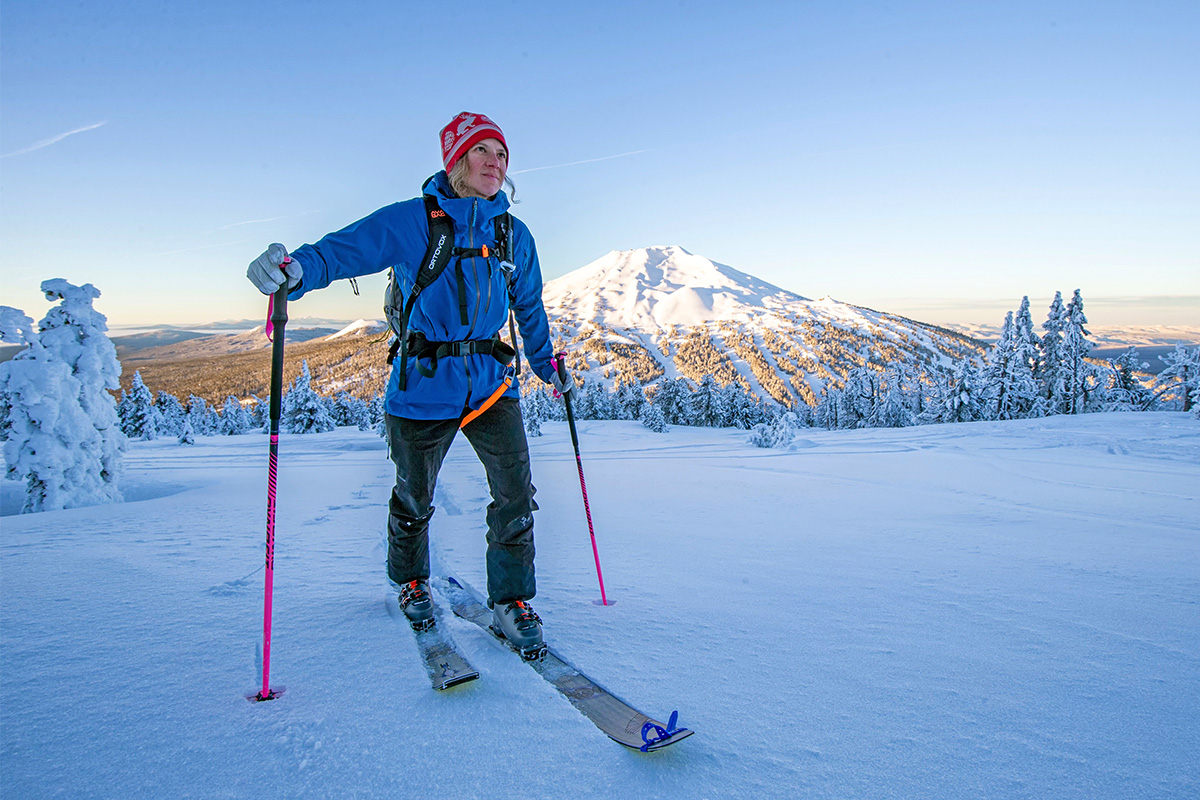

Price: $449
Weight: 1 lb. 5.2 oz. (women's)
Waterproofing: 3L H2No
What we like: Very stretchy and breathable, which is great for high-output ski touring.
What we don’t: Not as impervious-feeling as similarly equipped Gore-Tex jackets; storage layout could be slightly improved.
See the Women's Patagonia SnowDrifter See the Men's Patagonia SnowDrifter
Patagonia offers a jacket for just about every type of skier and terrain, from insulated, resort-ready designs to lightweight hardshells built for the backcountry. The SnowDrifter slots in as their most affordable touring option with in-house waterproofing, a stretchy face fabric, and excellent breathability for uphill use. We tested the women's SnowDrifter over a season of backcountry and resort skiing in the Pacific Northwest and came away impressed with how well it held up to the range of conditions we faced. It doesn’t provide the same impenetrable feel as premium Gore-Tex models, but it’s a versatile and nicely appointed shell at a pretty palatable price. Below are our experiences with the SnowDrifter. To see how it stacks up to the competition, see our articles on the best ski jackets and best women's ski jackets. And to complete your kit, we've also tested and reviewed the SnowDrifter Bibs.
The Pacific Northwest is known for its variable conditions, and the Patagonia SnowDrifter Jacket has proven itself as a capable companion in everything Mother Nature has thrown my way. I tested this jacket throughout a full season of resort skiing and backcountry ski guiding and came away impressed with how it held up to rain, heavy snow, and gusts. Though it lacks the bombproof feel of a thicker Gore-Tex layer, Patagonia’s H2No construction (combined with a durable water-repellent finish along the exterior) hasn't shown any signs of weakness when it comes to water- or windproofing. In fact, the SnowDrifter has impressed me on multiple occasions during strong winds, including while transitioning on a brutally gusty ridgeline and sitting on chairlifts in blowing snow.
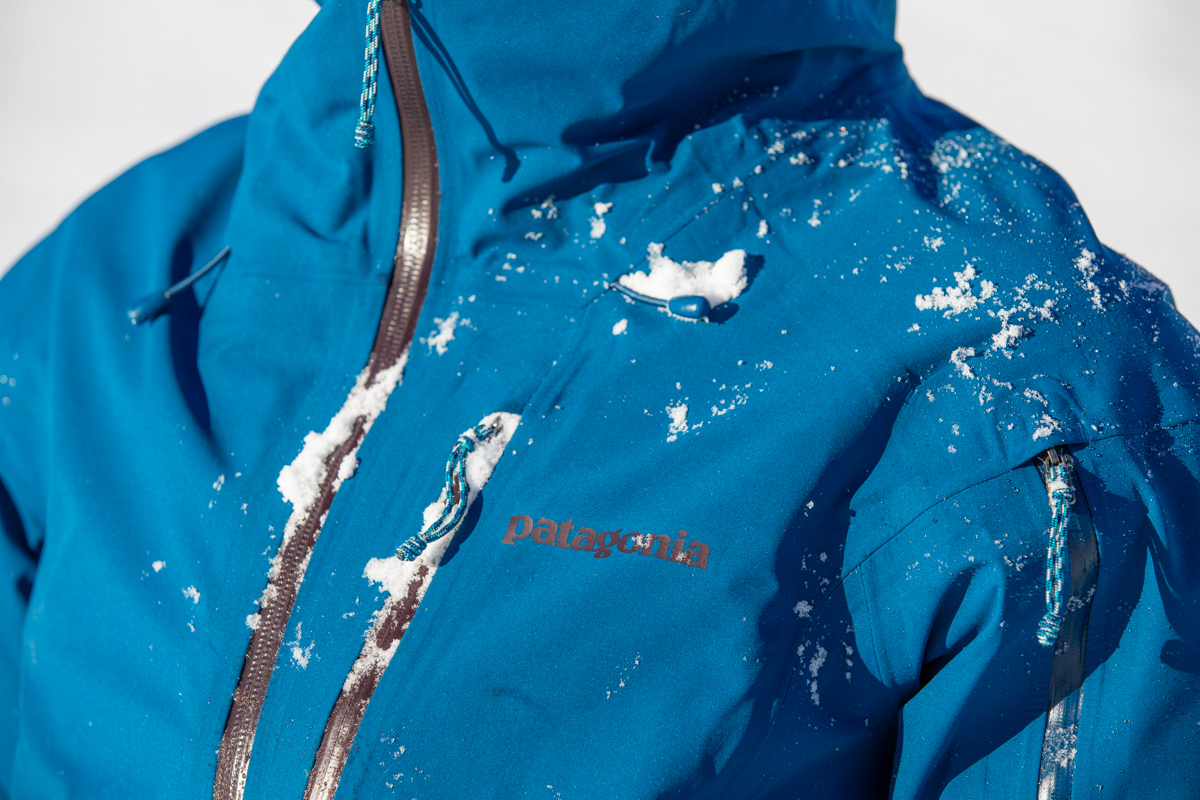
It helps that the SnowDrifter is fully seam-taped and comes equipped with watertight zippers and a full suite of protective features. Starting at the top, the hood is adjustable at the front and back and can be cinched over either a hat or ski helmet. Plus, the laminated visor provided extra security in drizzly weather. The hem and integrated powder skirt are both adjustable and add another barrier should you take a spill or venture into particularly deep powder. Finally, the cuffs are generously sized to fit over gloves but can also be cinched tight via a Velcro closure to slide underneath gauntlet-style gloves or mittens.
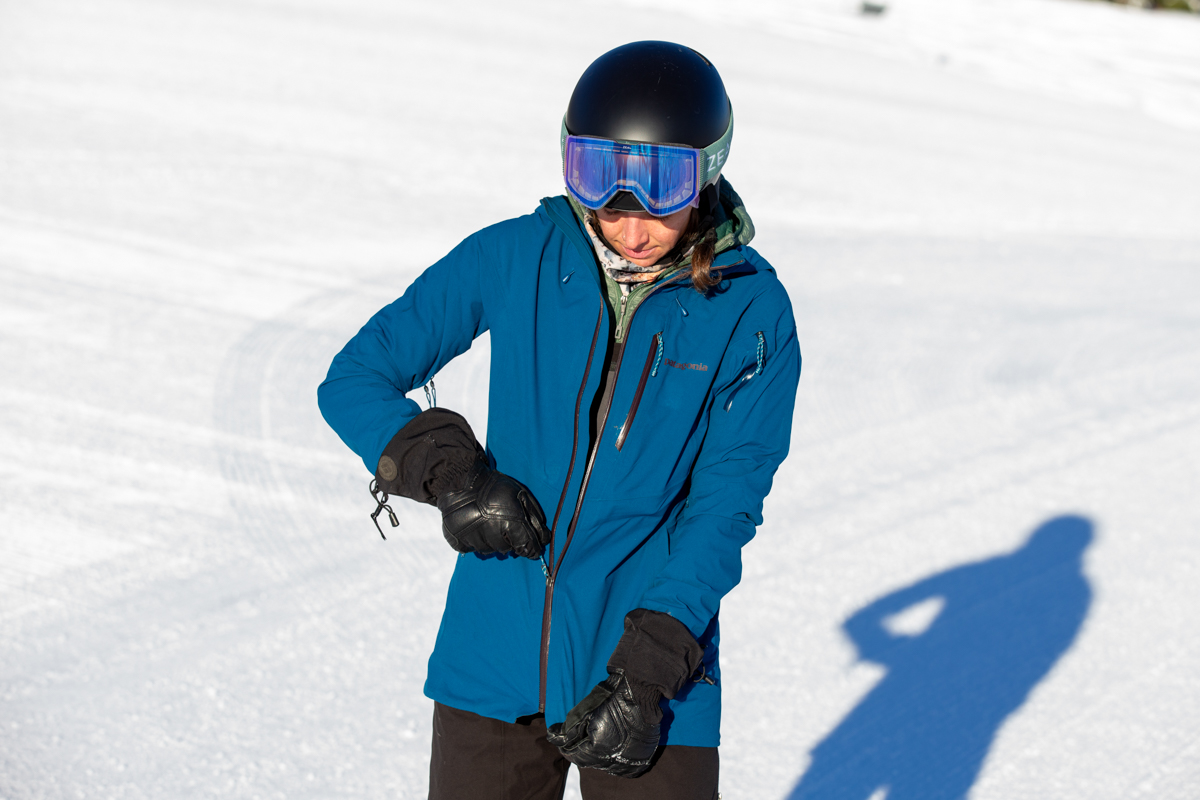
In addition to comfort and stretch, the Patagonia SnowDrifter is a true standout in the breathability department and again performs more like a softshell than a hardshell jacket. In practice, I’ve been able to comfortably skin in the jacket without overheating any time the temperature has dropped below freezing. I initially expected that I would need to stop and remove the shell in mild conditions, but I’ve been pleasantly surprised by how well the fabric breathes, and the soft liner is great at wicking moisture away from my skin. And if I really start to work up a sweat, I’m able to dump heat via generous, two-way pit zips (around 12 in.), though I’ve only had to revert to using them on particularly sunny and warm days.
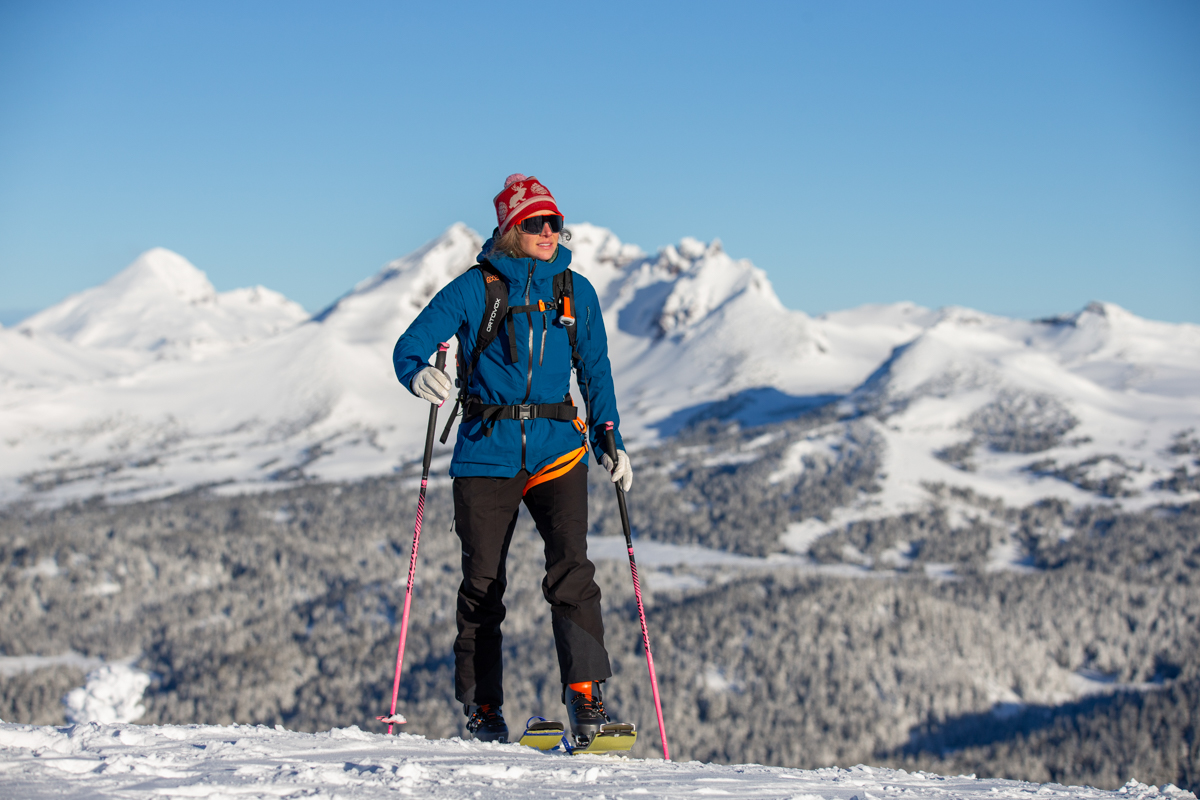
In my opinion, two of the SnowDrifter’s biggest selling points are its comfort and mobility, and the latest 2024 update features an even stretchier face fabric. I never experienced any restriction while skinning, adjusting my boots and bindings during transitions, or making turns downhill. In fact, I would go so far as to say that the SnowDrifter feels more like a softshell than a hardshell, which is very high praise for a backcountry-ready design. Another benefit is that it’s very quiet during movement, which is largely thanks to the knit backer, which is reminiscent of Gore's C-Knit backer. The supple fabric is also incredibly soft and smooth against the skin and slides nicely over baselayers and midlayers.
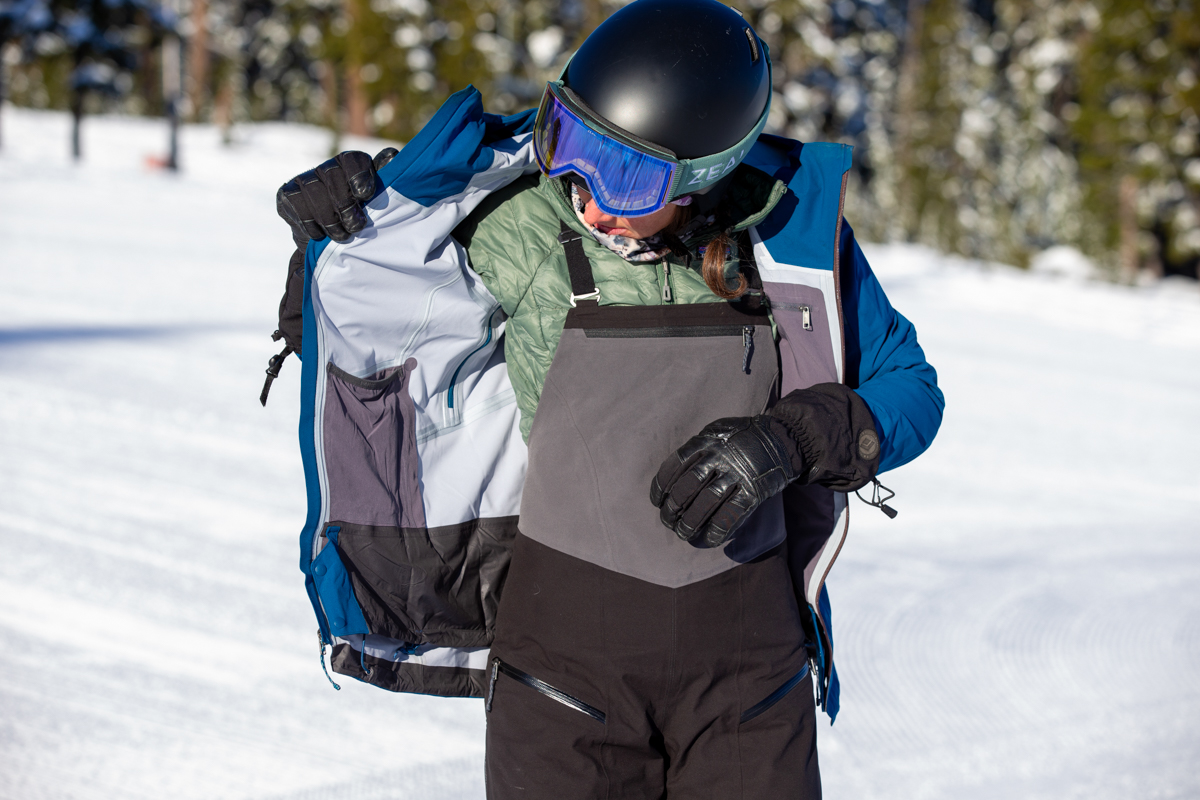
Patagonia is an industry leader in well-made, hardwearing snow gear and apparel, and the SnowDrifter Jacket is a testament to their expertise. So far, the shell is holding up well to rough use, including countless chairlift rides, being repeatedly stuffed into my ski backpack, and being haphazardly crammed into the back of my car. Further, the stitching, zippers, and seam taping are all still intact with no performance issues to date, and the jacket looks nearly as good as new after a couple months of consistent testing. That said, Patagonia opted for a thinner 50-denier (D) face fabric with their latest update to the jacket (the previous model had a 75D exterior). While this hasn't had any noticeable impact on protection or durability for me just yet, I'll be sure to update this review if any concerns crop up during future outings.
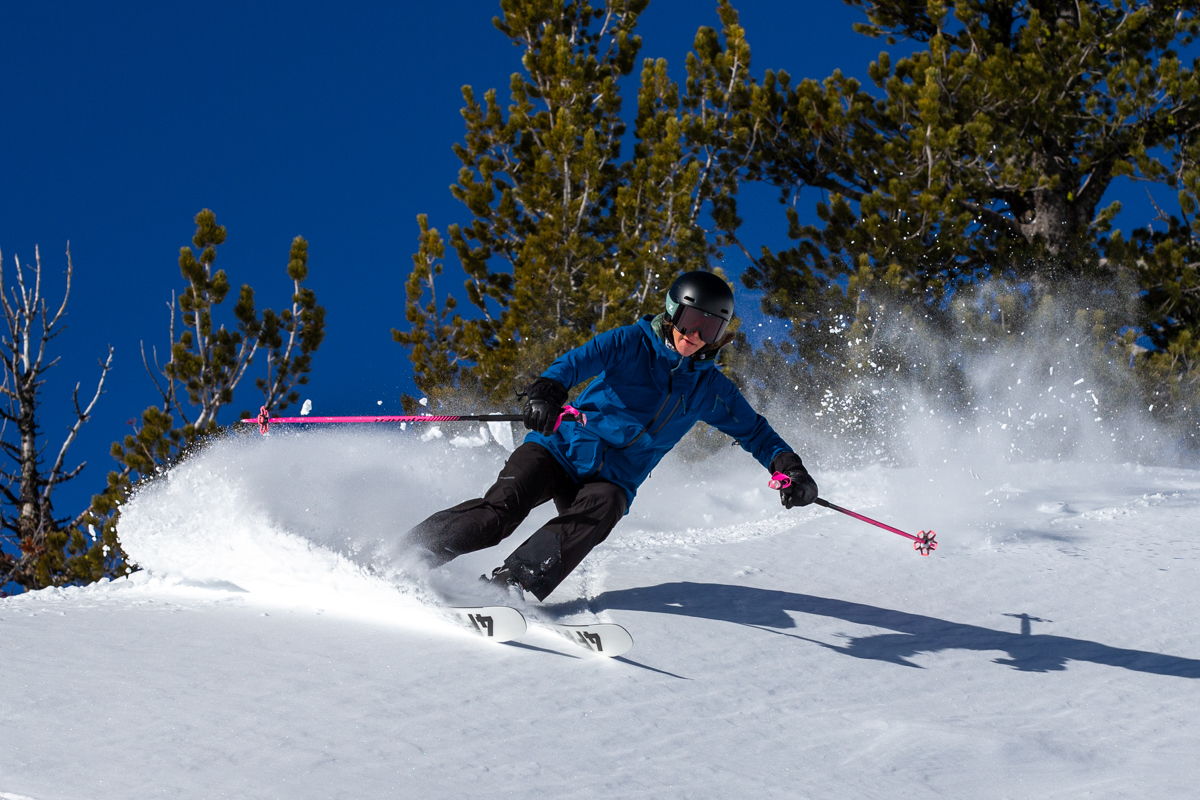
The women’s SnowDrifter Jacket weighs 1 pound and 5.2 ounces, which is right in line with most of the backcountry-focused competition. For reference, Arc'teryx's venerable Sentinel Jacket checks in at a nearly identical 1 pound 5.3 ounces, while Outdoor Research's Skytour Ascentshell Jacket weighs slightly less at 1 pound 4.5 ounces. You can certainly go lighter in this space—Patagonia's own Stormstride Jacket, for instance, is just 1 pound 1.6 ounces—but expect to make sacrifices in durability (the Stormstride uses a thinner shell fabric) and features. All told, considering the SnowDrifter's relatively uncompromised build, I feel the weight is well spent. And like most hardshells, it can be stuffed into its own hood for storage. Once compressed, it ends up being about the size of a cantaloupe, which fits easily into my 30-liter backcountry ski pack.
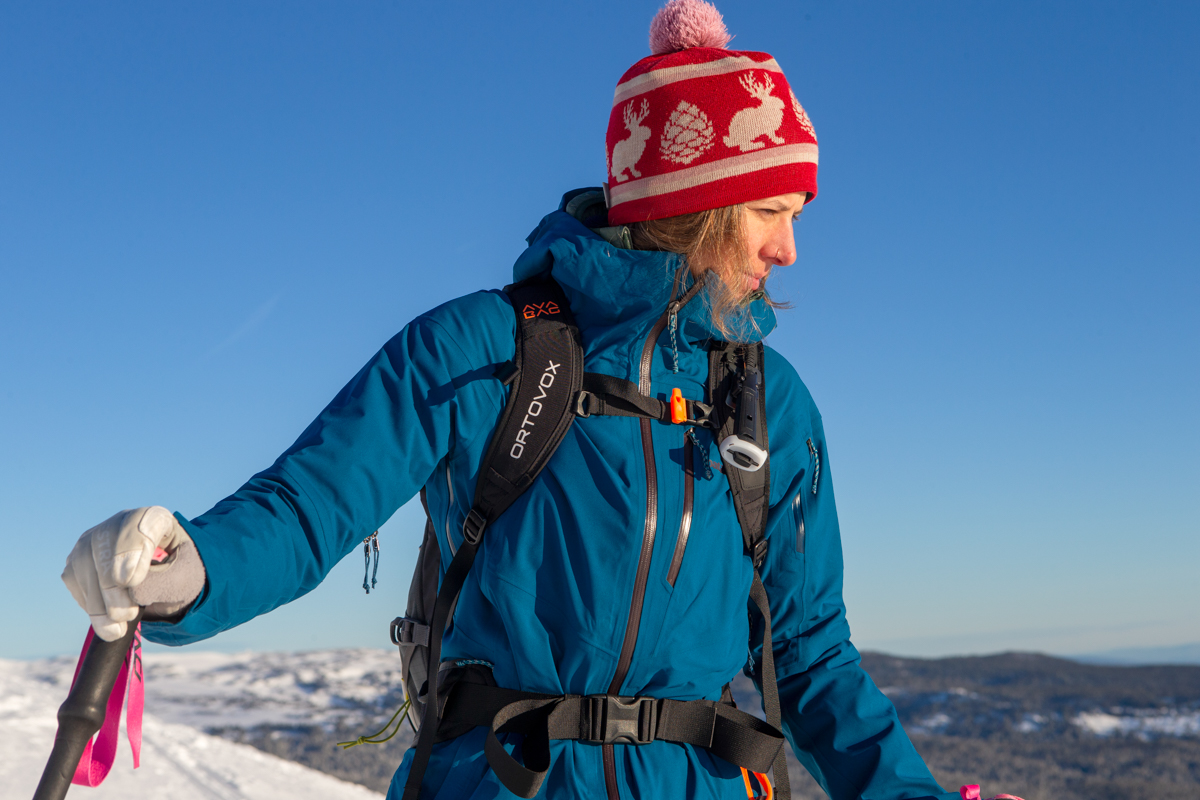
As I touched on above, the SnowDrifter’s hood pairs well over a ski helmet and can be cinched down to provide protection against snow and wind. The helmet is adjustable in two ways: There are pull tabs at either side of collar and a cinch at the back of the head. It did take some time to get used to the adjustments since the toggles are protected by tiny "pockets," which makes access particularly difficult with cold fingers or when wearing bulky ski gloves. But once I got used to the mechanics, I was able to tweak the fit of the hood on the fly without too much effort. The sleek design avoids excess fabric that can get caught in the wind or obstruct vision, and I didn't experience any restriction when looking over my shoulder. Finally, the low-profile brim offered a touch of extra coverage on wet days, helping keep snow and rain off my goggles when skiing inbounds.
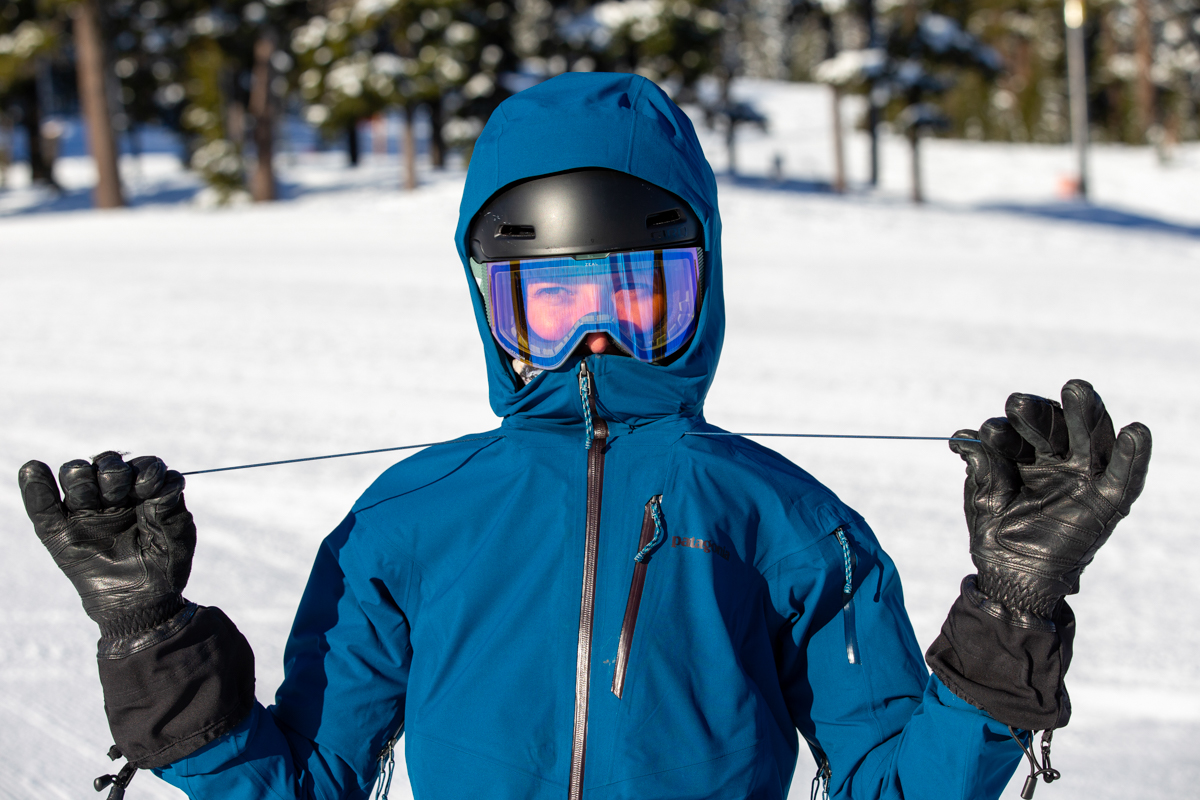
The SnowDrifter comes well equipped for stowing the essentials with six total pockets. On the outside, you get two large hand pockets that easily swallow gloved hands, even while wearing a pack. There’s also a smaller pocket on the bicep for stowing a lift pass, ID, or credit card, as well as a single chest pocket with a secondary compartment that opens from the interior (ideal for routing headphone cords through). On the inside, the aforementioned internal pocket is large enough to fit my iPhone (complete with its bulky case), and a dump pocket easily and securely stows ski goggles, gloves, or a beanie. Given the SnowDrifter's backcountry intentions, I wish there were a spot to stash climbing skins (none of the internal pockets are big enough), and I was also unable to find a good spot for my AIARE field book, which many backcountry skiers carry. But overall, despite being a little underbuilt for touring, I found the jacket's storage layout to be entirely adequate for most days out—whether I was skiing inbounds or venturing into the mountains.

For added protection in the event of a fall or when the snow is especially deep, Patagonia outfitted the SnowDrifter with an adjustable powder skirt. Unlike some designs, the Patagonia’s skirt isn’t removable, but it’s fairly unobtrusive and has gone largely unnoticed throughout the season. In terms of adjustability, the skirt can be cinched for a tight seal with a series of buttons, plus it can be connected via a webbing loop at the back to any Patagonia snow pants. I'm admittedly not a fan of connecting my jacket and pants, so I can't comment on how well the two integrate, but the powder skirt on its own is very functional.

Patagonia describes the SnowDrifter Jacket as having a “regular” fit, which translates to ample room for baselayers and midlayers without feeling overly bagging or unshapely. Following Patagonia’s sizing guide, I landed between an extra-small and small, but I was glad I went with the larger size to comfortably accommodate a synthetic jacket underneath. Additionally, the sleeve length was perfect for me: Even with my arms lifted to adjust the pit zips, I still had plenty of coverage. And finally, the center back length (29.6 in.) stacks up very competitively to the rest of the market and nicely protects against snow and cold entering under the shell when I bend over.
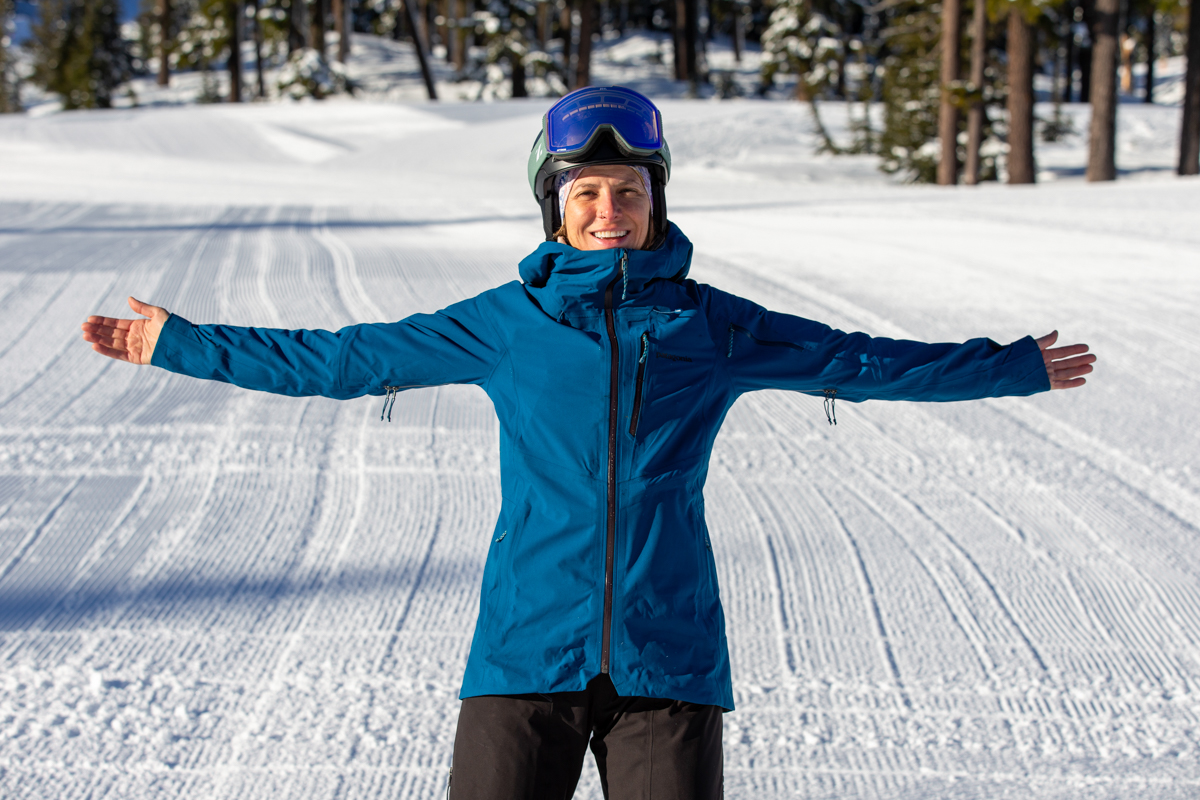
Patagonia has long been a leader in environmental initiatives, and the SnowDrifter incorporates many of their key sustainability measures. Specifically, the shell uses 100%-recycled polyester and is made without the use of PFAS—per- and polyfluoroalkyl substances that have been dubbed "forever chemicals" due to their inability to break down over time. The jacket is also made in a Fair Trade Certified factory, which indicates Patagonia put extra money into production to ensure that workers are being compensated fairly and have access to healthcare programs, childcare services, and more (you can read more about the program here). Added up, we appreciate the brand's transparency and ongoing commitment to creating sustainably built clothing.
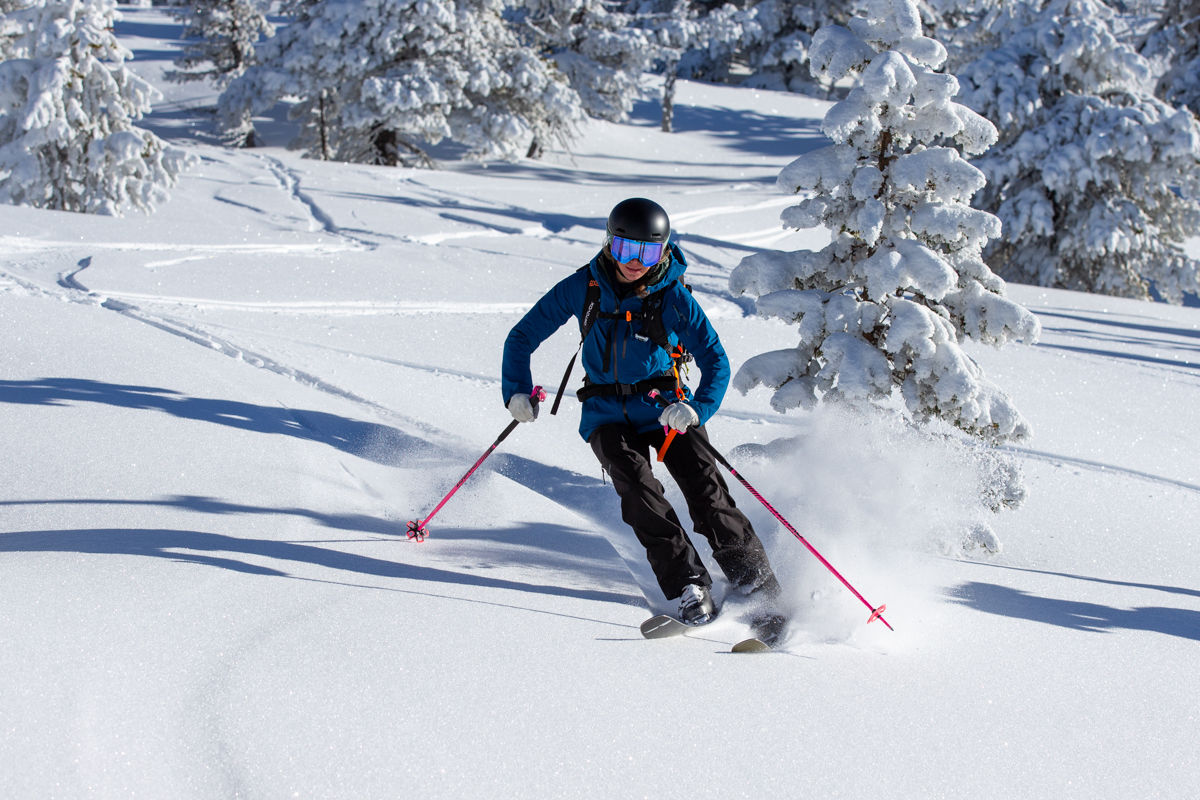
I tested the women’s SnowDrifter Jacket for this review, and Patagonia makes a nearly identical men’s version. The men’s SnowDrifter Jacket costs the same at $449 and boasts a very similar feature set and construction, including a 3-layer H2No build, 50-denier face fabric, six total pockets, powder skirt, and adjustability at the hem, hood, and cuffs. The men’s model weighs slightly more at 1 pound 5.9 ounces and comes in different colorways, but you can expect similar overall performance. Rounding out the collection, Patagonia makes SnowDrifter Bibs for both men and women, which retail for $399 and use the same stretchy H2No build with a soft knit backer (check out our in-depth review of the women's model here).
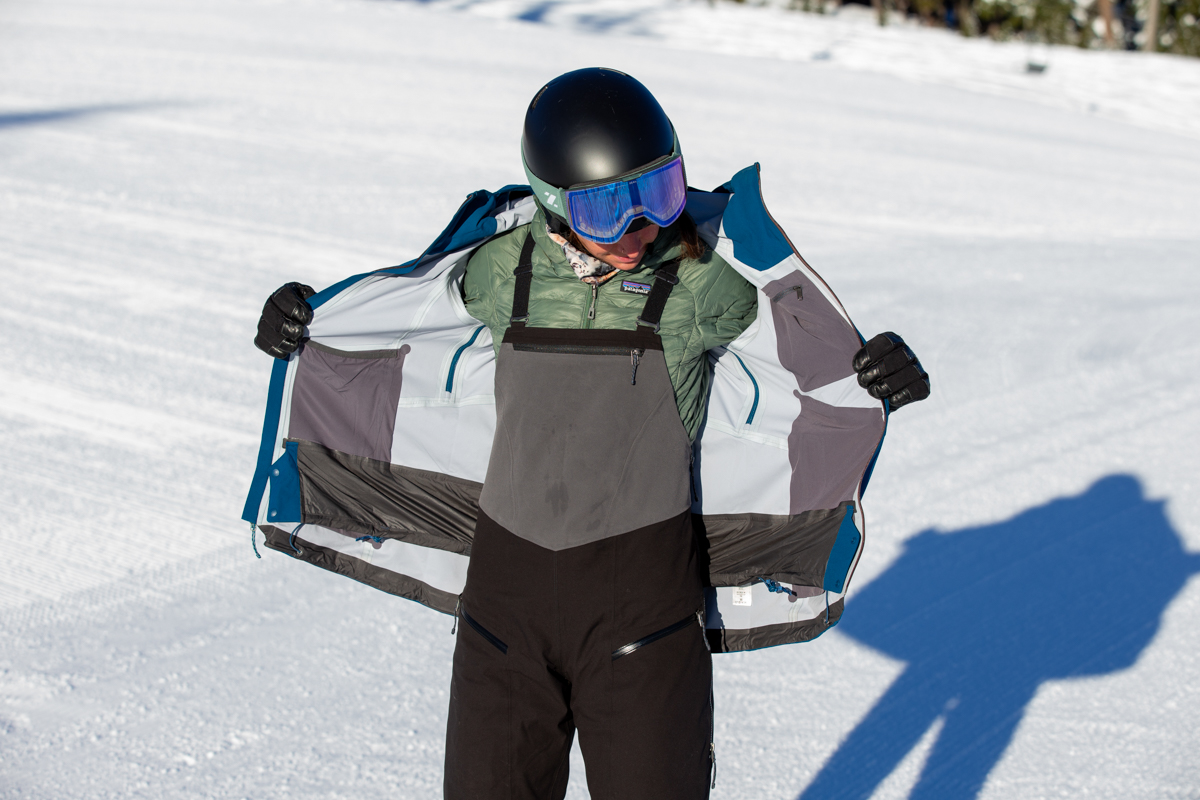
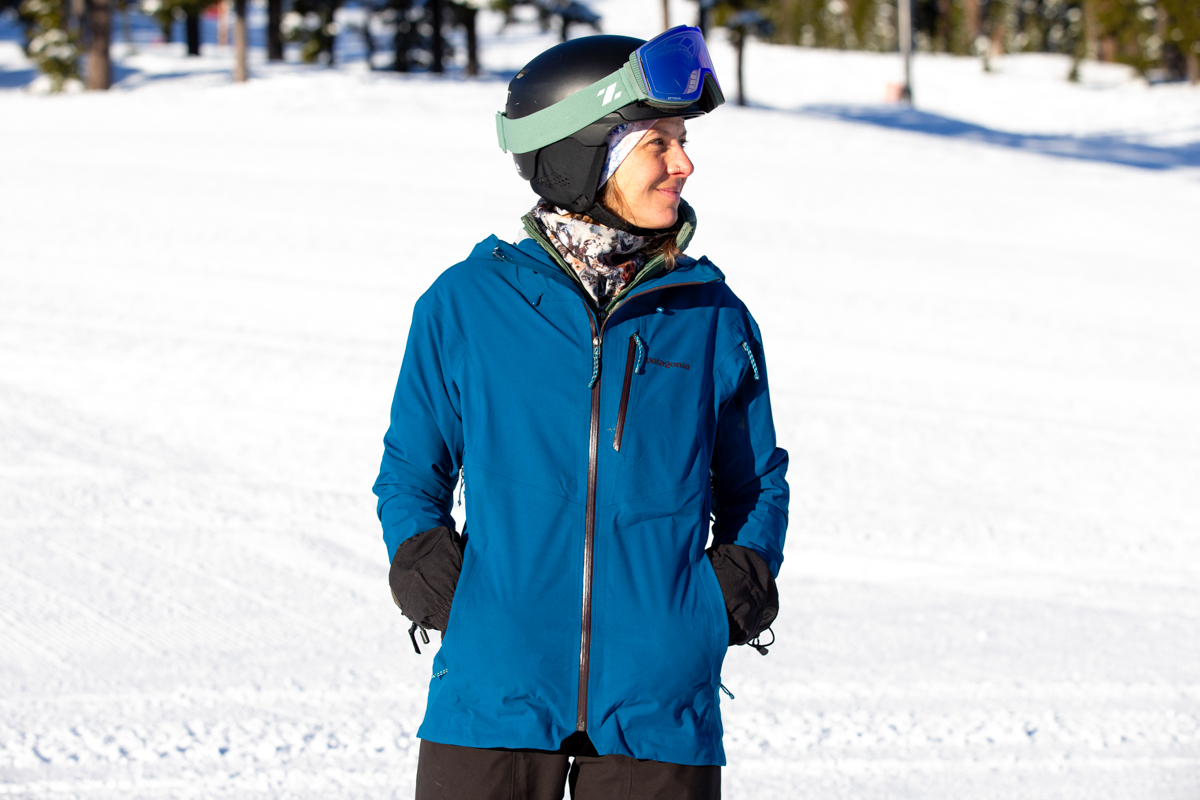
| Jacket | Price | Best For | Waterproofing | Weight | Denier | Recco |
|---|---|---|---|---|---|---|
| Patagonia SnowDrifter | $449 | Backcountry/resort | 3L H2No | 1 lb. 5.2 oz. | 50D | Yes |
| Patagonia Stormstride | $499 | Backcountry | 3L H2No | 1 lb. 1.6 oz. | 40D | Yes |
| Flylow Gear Lucy Jacket | $400 | Backcountry/resort | 3L Tactic | 1 lb. 5.6 oz. | 100D | No |
| OR Skytour AscentShell | $429 | Backcountry | 3L AscentShell | 1 lb. 4.5 oz. | 40Dx65D | No |
| Arc'teryx Sentinel Jacket | $750 | Resort/backcountry | 3L Gore-Tex | 1 lb. 5.3 oz. | 80D | Yes |
Patagonia’s SnowDrifter impressed us with its comfort and breathability, but the brand has a few other capable options for those who like to venture deep into the backcountry. The Stormstride Jacket is an intriguing alternative with a very similar build: Like the SnowDrifter, the Stormstride uses a 3-layer H2No construction and polyester knit backer for softshell-like comfort and mobility. In parsing out the differences, the Stormstride is lighter by around 4 ounces, and its woven shell offers a bit more “give,” but you compromise on durability and organization with a relatively thin 40D shell and no hand pockets. For $50 less, we think the SnowDrifter is more well rounded and the better value, but the Stormstride’s lower weight and added stretch are enticing for committed backcountry enthusiasts.
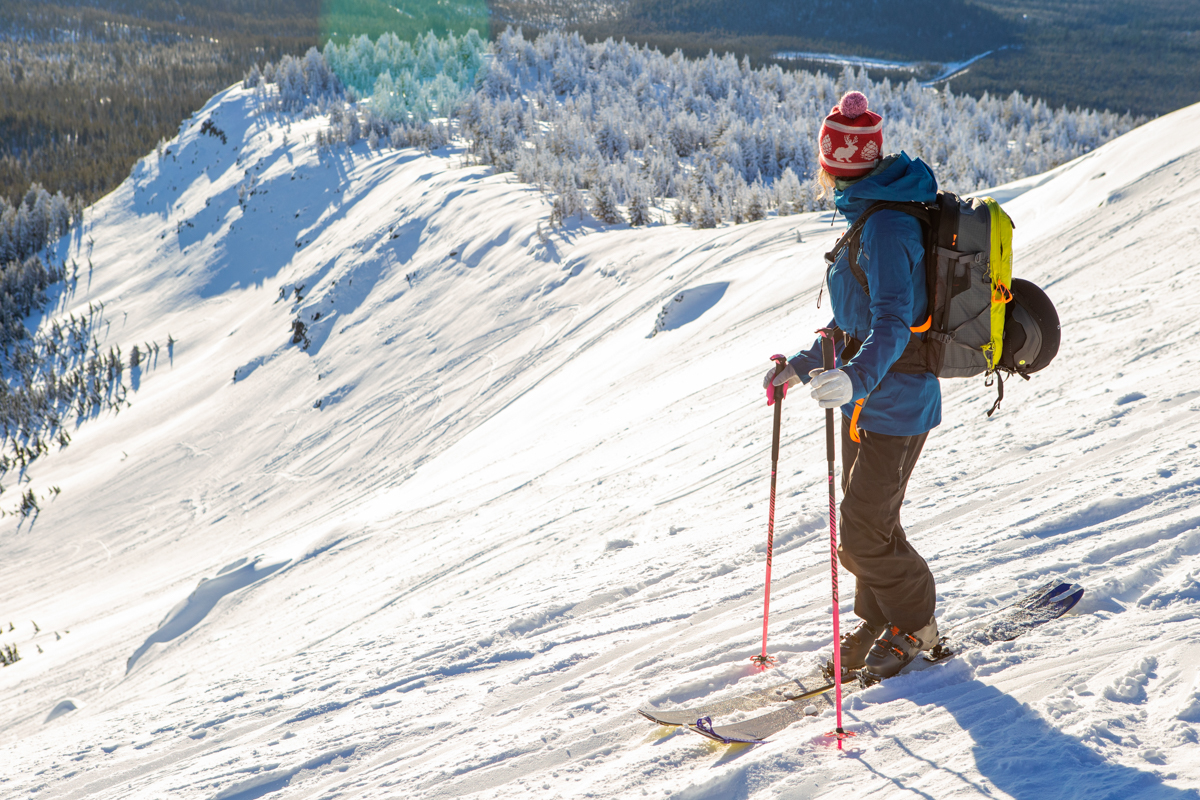
Hailing from Colorado, Flylow Gear has an impressive lineup of ski and snowboard apparel, and their Lucy (and men’s Malone) is one of our favorite crossover backcountry/resort options. Like the SnowDrifter, the Lucy is incredibly soft and breathable like a softshell but still offers great all-around protection thanks to a 3-layer waterproof build and noticeably robust (100D) exterior. It’s also a strong value at $400 and checks in around the same weight at 1 pound 5.6 ounces. That said, we had a couple notable gripes with the Lucy during testing, including the lack of internal dump pocket (helpful for stowing skins, goggles, etc.) and restriction to movement at the collar/neck area with the hood up and jacket fully zipped. For around $50 more, the Patagonia strikes us as the slightly better-built shell, but the Lucy isn’t far behind and is offered in more attractive colorways.
Outdoor Research makes a similar design to the SnowDrifter in their Skytour AscentShell Jacket. Like the Patagonia, the Skytour uses OR’s in-house AscentShell membrane, which we’ve found to be impressively stretchy and mobile but still fully waterproof (although it’s still a step down in all-out wind and water protection from premium Gore-Tex). In parsing out the differences, the OR shell is a little lighter at 1 pound 4.5 ounces, has a longer center back length (31.5 in.) for improved coverage when bending over or sitting down, and gets the advantage in storage with seven total pockets. The Skytour omits a powder skirt and Recco reflector, and we consider the Patagonia to be the more refined piece overall, but the Skyward nevertheless is an excellent value and a very capable alternative for those who exclusively ski in the backcountry.
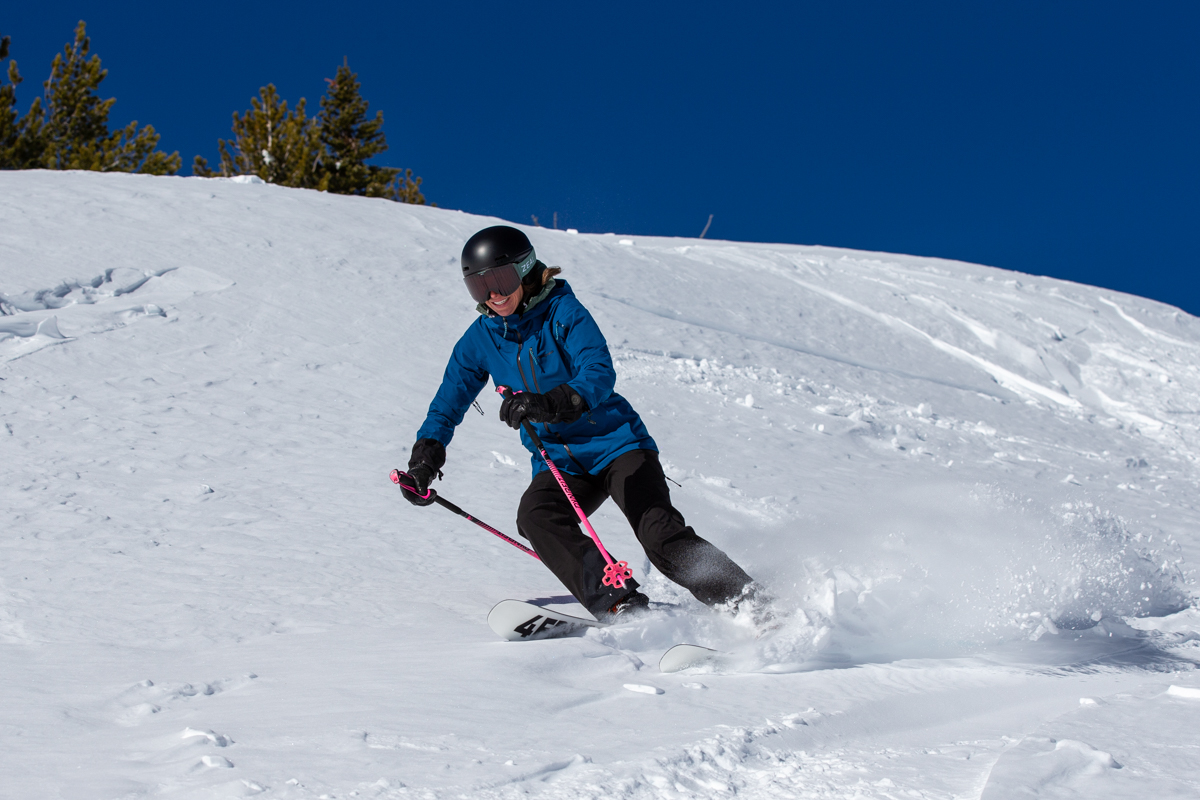
Last but not least, we’d be remiss to leave out Arc’teryx’s venerable Sentinel (and men’s Sabre Jacket). Right off the bat, we’ll note that the Sentinel is an ultra-premium design that costs $750, but it comes with a host of upgrades. First and foremost, the Sentinel boasts a more protective 3-layer Gore-Tex build and comfortable flannel backer, which adds a modest dose of warmth for cold resort days. You also get a more durable 80D construction and similar overall feature set for around the same weight. And we can't help but love the Sentinel's trendy freeride styling, which makes it easy to layer underneath while still appearing very sleek and streamlined. The SnowDrifter pulls ahead in breathability, but for extreme weather and truly inclement alpine conditions, the choice is clear: Go with the more durable and storm-ready Sentinel.
If you’re thinking about buying gear that we’ve reviewed on Switchback Travel, you can help support us in the process. Just click on any of the seller links above, and if you make a purchase, we receive a small percentage of the transaction. The cost of the product is the same to you but this helps us continue to test and write about outdoor gear. Thanks and we appreciate your support!
Depending on the seller, most products ship free in the United States on orders of $50 or more. International shipping availability and rates vary by seller. The pricing information on this page is updated hourly but we are not responsible for inaccuracies.